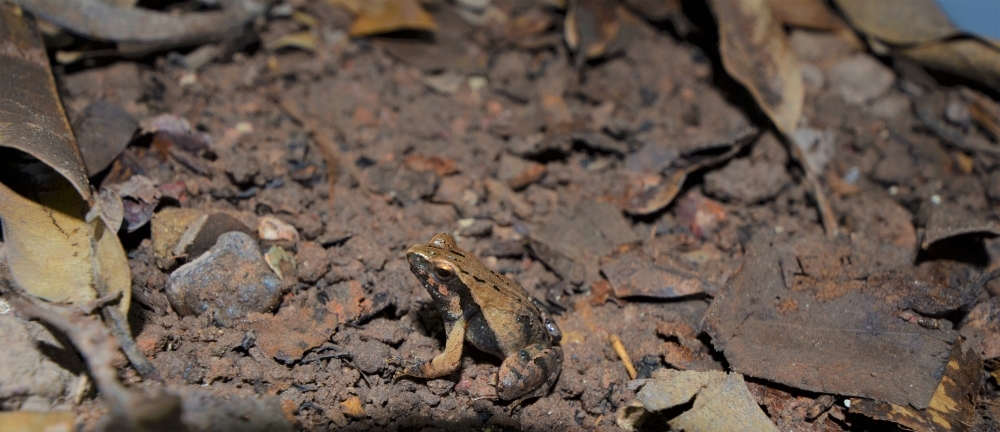


Using advanced molecular biology techniques, researchers discover that two frog species widely distributed in Brazil may actually be as many as seven, some exclusive to the Amazon. The change in classification could require new conservation actions (photo: Gilda V. Andrade / UFMA)
Published on 05/04/2021
By André Julião | Agência FAPESP – Even for a frog expert, it is practically impossible to distinguish between the species Physalaemus cuvieri and Physalaemus ephippifer only by looking at them. Both frog species can be found in flooded savannas and pastureland ponds from the Amazon in Brazil’s far north to Rio Grande do Sul, its southernmost state. Roughly speaking, the consensus is to refer to specimens from the North Region as P. ephippifer (Steindachner's dwarf frog) and to the rest as P. cuvieri (barker frog).
Now, however, new research funded by FAPESP suggests that this group of amphibians may comprise not two but four species, or possibly as many as seven, distinguishable with precision only by means of advanced molecular biology techniques.
To date, no morphological traits have been sufficient to distinguish these frogs. They all have a brown head and back, irregular dark stripes along both flanks, and red spots on the inside of their thighs and groin. No significant differences have been observed in the male mating calls. However, sufficiently robust cytogenetic and molecular differences have now been found to justify a subdivision.
The new study, published in Frontiers in Genetics – Evolutionary and Population Genetics, was conducted by Brazilian researchers affiliated with the University of Campinas (UNICAMP) in São Paulo state, São Paulo State University (UNESP), the Amapá State Scientific and Technological Research Institute (IEPA) and the Federal University of Maranhão (UFMA) in collaboration with researchers at institutions in Argentina and the United States.
“In theory, this group of anuran amphibians [frogs and toads] comprises two species. Some years ago, however, we conducted a study of the karyotypes [collection of chromosomes, DNA-containing molecules] of specimens from this group and began to suspect that there might well be other species in the group in addition to the two already described,” said Luciana Bolsoni Lourenço, a professor at UNICAMP’s Institute of Biology (IB) and principal investigator for the study.
The study mentioned by Lourenço was part of a project funded by FAPESP. To investigate the hypothesis formulated, the group collected frogs from the two previously described species in ten different localities in Brazil’s North Region, nine in western Pará state and one in the state of Roraima. They also increased the number of molecular markers – DNA sequences capable of revealing differences among individuals – used to classify the species.
Lourenço performed part of the research during an internship at the University of Tennessee in the United States with the support of FAPESP and the collaboration of Benjamin Minault Fitzpatrick, a coauthor of the article.
The study was also part of a FAPESP-funded Thematic Project and was supported by a research grant from the FAPESP program Research Partnership for Technological Innovation (PITE), in both cases with Célio Fernando Baptista Haddad as principal investigator. Haddad is a professor at UNESP’s Rio Claro Institute of Biosciences and a coauthor of the article.
Tools
Despite the molecular differences, which the inclusion of restriction-site associated sequencing (RAD-seq) markers made even more evident, the formal description of new species still requires knowledge of a more classical kind.
To be able to classify the species as cryptic – differing only at the molecular level – the researchers must make sure there are no distinguishing morphological or acoustic features. They also need to analyze more individuals from outside Amazonia because the sample has to be larger and more representative.
The fact that the animals are physically so alike raises the possibility of interbreeding between the species. Data not yet published by the group point to evidence of contact between the different genetic lineages in certain areas. For this reason, researchers are now interested in determining whether the differences in karyotypes may have played a role in the isolation of these lineages.
One trait that distinguishes P. ephippifer from all the other lineages recognized to date, for example, is sex chromosome heteromorphism. Females of this species have heteromorphic sex chromosomes, meaning they are easily distinguishable since the female chromosome set differs from that of males. Sex chromosomes in the other species are homomorphic – identical in males and females.
“One hypothesis is that differences in sex chromosomes entail a reproductive barrier that may have contributed to the isolation of some lineages,” Lourenço said.
Conservation
The discovery that this group, which previously comprised two species, may in fact contain between four and seven species could have an impact on conservation management. P. cuvieri and P. ephippifer are currently classed as of “least concern” by the IUCN Red List of Threatened Species.
It is not known whether this status will apply to the new members of the group, which may live in areas more susceptible to human activity, for example.
“When two species are distributed in a large number of localities, the conservation policy concern may be very different than when several species occur in more restricted areas,” Lourenço said.
The article “Extensive cryptic diversity within the Physalaemus cuvieri-Physalaemus ephippifer species complex (Amphibia, Anura) revealed by cytogenetic, mitochondrial, and genomic markers” (doi: 10.3389/fgene.2019.00719) by Juliana Nascimento, Jucivaldo D. Lima, Pablo Suárez, Diego Baldo, Gilda V. Andrade, Todd W. Pierson, Benjamin M. Fitzpatrick, Célio F. B. Haddad, Shirlei M. Recco-Pimentel and Luciana Bolsoni Lourenço can be read at www.frontiersin.org/articles/10.3389/fgene.2019.00719/.
Source: https://agencia.fapesp.br/32451